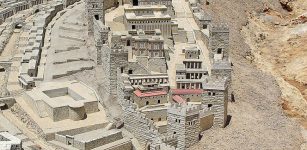Advanced Technology Of The Ancients: Artificial Platforms Of Mighty Nan Madol
A. Sutherland - AncientPages.com - Two very remarkable islands - Kosrae and Pohnpei ("upon a stone altar") - can be found in the Caroline Islands, a widely scattered archipelago located in the western Pacific Ocean, to the north of New Guinea and more than 1,500 miles to the east of the Philippines.
The ruins of Nan Madol on Pohnpei Island. Image credit: NOAA - Public Domain
These two places are full of mysteries, particularly because of bizarre remains of ancient architecture, in the form of very old megalithic cities, of which origin no one is able to guess."
Those, who do not invalidate the myths and legends of the ancients, can ponder over some interesting legends and myths. One of them says that "magic powers" were used to transport the logs from a far-away location, by making them fly and yet another legend supports the latter, saying about a mighty "magician" who made the logs fly towards Nan Madol, where the city was constructed and a firebreathing dragon became its symbol.
Who was interested in building two of the Pacific's largest basalt cities?
How were the huge, very heavy basalt columns and logs quarried and transported? In what manner were the walls constructed so high?
Who built the megalithic complexes, when and why were they built on both islands, at all?
Legends say that giants once lived on Ponape and archaeologists have discovered human bones belonging to people much taller than the natives of the region. They had at their disposal the physical means to carry the heavy basalt logs and built walls as high as 50 feet and as thick as 17 feet.
The inhabitants of both islands have absolutely no idea about their origin because the ruins were already in place at the time of the arrival of the early settlers.
The ruins of Nan Madol in Pohnpei. Image credit: CT Snow - CC BY 2.0
The ruins on the island of Kosrae are known among the white people as the "city of kings, and among the natives as "Insaru". They were built of huge hexagonal stone blocks and many of them have a mass between 30 to 60 tons, and according to a professional opinion of civil engineers and architects, the hexagonal blocks must be cut with mathematical exactness in all their dimensions.
A survey conducted on the Lelu Stone Ruins of Kosrae since 1978, showed west of the hill was artificial — a 0.6-1.0 meter deep fill of coral and basalt stone, with man-made extensions of the island, which bravely resist tropical cyclones of the Pacific Ocean.
Today, the ruined city on Kosrae has been reclaimed by the jungle and it is not visited so frequently as neighboring Nan Madol on Ponape. Nan Madol is a strange place, built into the ocean (!) which means that it is not located on the dry land of Ponape Island.
The origin of the basalt building stones used to construct Nan Madol is old. Basalt was most probably transported from only one far-away location on the opposite side of the island to the coral reef.
As no traces of prehistoric machines were found., archaeologists speculated that the builders used rafts. However, all attempts to use rafts to transport heavy construction material - failed because heavy, iron rich hard rock immediately sank due to its weight.
"Immense columns of prismatic basalt rock, quarried from various locations around the island, formed high-walled rectangular enclosures for the coral rubble used as fill for the islets' floor. Built over an extended period of time, Nan Madol eventually came to consist of ninety-two artificial islets that covered an area of 200 acres.. The most spectacular of the complex's structures reached a height of 25 feet..." (D.L. Hanlon)
It is estimated that at least 250 million tons of basalt logs are needed to construct a city, the size of Nan Madol and relatively long distance that separates Ponape island from the larger landmasses makes the history of the ruins fascinating.
At the peak of the last glacial maximum, Ponape Island was situated over a thousand kilometers to the north from the eastern edge of the Peninsula and the chain of islands, which today, partly form the Solomon Archipelago.
But the truth is that nobody knows when the megalithic complex was built and this is one of the biggest mysteries of archaeology.
All that's left of the earlier prehistoric city was named by the natives as "Nan Madol" and means "spaces between". The name may refer to an extended system of channels but it can mean something completely different. According to some opinions, Nan Madol could have been some religious and ceremonial center, but... was it?
"No site in Oceania surpasses the dramatic beauty of ancient Nan Madol... situated on the coast of Pohnpei, the elite administrative and ceremonial center grew, flourished and declined during the centuries preceding Western contact..." (W. N. Morgan)
It is a magnificent complex of ninety-two artificial islets interconnected by a network of waterways and according to Dr. Ayres, Professor of Anthropology at the University of Oregon and a researcher at Nan Madol, with extensive experience in Pacific archaeology, "to withstand time and the sea, the artificial platforms were built in a staggeringly laborious process."
"Multiton basalt columns, formed by volcanic activity, were stacked horizontally, log-cabin style, to form outer walls..."
Written by – A. Sutherland - AncientPages.com Senior Staff Writer
Copyright © AncientPages.com All rights reserved. This material may not be published, broadcast, rewritten or redistributed in whole or part without the express written permission of AncientPages.com
Expand for referencesReferences:
Ehrlich P., Hadley M., Nan Madol: Spaces on the Reef of Heaven
Morgan, William N. Prehistoric Architecture in Micronesia
More From Ancient Pages
-
 Nue – Mysterious Mythological Shape-Shifting Creature Transforming Into A Black Cloud
Featured Stories | Jun 12, 2020
Nue – Mysterious Mythological Shape-Shifting Creature Transforming Into A Black Cloud
Featured Stories | Jun 12, 2020 -
 Can This Ancient Coin Solve The Mysterious Disappearance Of Pirate Henry Every?
Archaeology | Apr 1, 2021
Can This Ancient Coin Solve The Mysterious Disappearance Of Pirate Henry Every?
Archaeology | Apr 1, 2021 -
 Peopling the Americas: Not “Out of Japan” – Popular Theory Debunked
Archaeology | Oct 13, 2021
Peopling the Americas: Not “Out of Japan” – Popular Theory Debunked
Archaeology | Oct 13, 2021 -
 On This Day In History: World War II: Battle Of Cape Esperance Was Fought – On October 11, 1942
News | Oct 11, 2016
On This Day In History: World War II: Battle Of Cape Esperance Was Fought – On October 11, 1942
News | Oct 11, 2016 -
 New Theory On “Dry Moat” At The Pyramid Of Pharaoh Djoser
Archaeology | Jul 3, 2019
New Theory On “Dry Moat” At The Pyramid Of Pharaoh Djoser
Archaeology | Jul 3, 2019 -
 Edfu Texts Reveal Secrets Of Predynastic Egypt And Zep Tepi
Featured Stories | May 27, 2021
Edfu Texts Reveal Secrets Of Predynastic Egypt And Zep Tepi
Featured Stories | May 27, 2021 -
 Researchers Confirm Museum Shrunken Head As Human Remains
Archaeology | Aug 4, 2022
Researchers Confirm Museum Shrunken Head As Human Remains
Archaeology | Aug 4, 2022 -
 Mysterious Biblical Celestial City And Its Connection To The North Star – The Arrival – Part 2
Biblical Mysteries | Feb 26, 2021
Mysterious Biblical Celestial City And Its Connection To The North Star – The Arrival – Part 2
Biblical Mysteries | Feb 26, 2021 -
 Extraordinarily Well-Preserved 3,000-Year-Old Octagonal Sword Unearthed In Germany
Archaeology | Jun 15, 2023
Extraordinarily Well-Preserved 3,000-Year-Old Octagonal Sword Unearthed In Germany
Archaeology | Jun 15, 2023 -
 Eastern Necropolis Of Ancient Thracian And Roman City Of Serdica – Unearthed
Archaeology | Apr 10, 2017
Eastern Necropolis Of Ancient Thracian And Roman City Of Serdica – Unearthed
Archaeology | Apr 10, 2017 -
 Unexplained Mystery Of The Glowing Woman Who Baffled Scientists
Featured Stories | Jun 6, 2022
Unexplained Mystery Of The Glowing Woman Who Baffled Scientists
Featured Stories | Jun 6, 2022 -
 Were Mysterious Giant Ancient Mustatils In Saudi Arabia Used For Ritual Purposes?
Archaeology | Mar 16, 2023
Were Mysterious Giant Ancient Mustatils In Saudi Arabia Used For Ritual Purposes?
Archaeology | Mar 16, 2023 -
 Discovery Of Stone Age Textiles Sheds New Light On The History Of Clothes Making
Archaeology | Nov 9, 2021
Discovery Of Stone Age Textiles Sheds New Light On The History Of Clothes Making
Archaeology | Nov 9, 2021 -
 Ambition, Greed And Death: The Roman Roots Of ‘Game Of Thrones’
Featured Stories | Jul 2, 2019
Ambition, Greed And Death: The Roman Roots Of ‘Game Of Thrones’
Featured Stories | Jul 2, 2019 -
 Cinnabar And Hematite Were Used In Early Teotihuacan Murals – INAH Researchers Say
Archaeology | Aug 5, 2020
Cinnabar And Hematite Were Used In Early Teotihuacan Murals – INAH Researchers Say
Archaeology | Aug 5, 2020 -
 Will Egypt be able to buy back the 4500-year-old statue of Sekhemka?
Artifacts | Aug 26, 2015
Will Egypt be able to buy back the 4500-year-old statue of Sekhemka?
Artifacts | Aug 26, 2015 -
 Has a 2,000 Year Old Podium Been Found in the City of David?
Civilizations | Sep 2, 2015
Has a 2,000 Year Old Podium Been Found in the City of David?
Civilizations | Sep 2, 2015 -
 Hogmanay: Scotland’s New Year Celebration Inherited From The Vikings
Ancient Traditions And Customs | Dec 31, 2016
Hogmanay: Scotland’s New Year Celebration Inherited From The Vikings
Ancient Traditions And Customs | Dec 31, 2016 -
 Ymir – Primordial Norse Giant Whose Body Parts Formed The World
Featured Stories | Apr 5, 2018
Ymir – Primordial Norse Giant Whose Body Parts Formed The World
Featured Stories | Apr 5, 2018 -
 Mystery Of The Horned Serpent In North America, Mesopotamia, Egypt And Europe
Egyptian Mythology | Dec 7, 2017
Mystery Of The Horned Serpent In North America, Mesopotamia, Egypt And Europe
Egyptian Mythology | Dec 7, 2017


